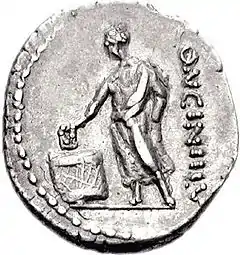List of Roman tribes
Tribes (Latin tribus) were groupings of citizens in ancient Rome, originally based on location. Voters were eventually organized by tribes, with each Roman tribe having an equal vote in the Tribal Assembly.
| Part of a series on |
| Indo-European topics |
|---|
 |

Original tribes
Latin tribus perhaps derives from the Latin word for "three", trēs. The Romans believed that through much of the early regal period of Roman history, there were only three tribes:[1]
- Ramnes
- Tities
- Luceres
These names were also preserved in the names of six of the later centuries of Roman equites.
Later tribes
Livy records that in 495 BC the number of tribes was increased to 21,[2] and the number of tribes reached 35 in 242 BC and was not expanded further.
Urban tribes
Attributed by Livy to the sixth Roman king, Servius Tullius,[3] the urban tribes were named for districts of the city and were the largest and had the least political power. In the later Republic, poorer people living in the city of Rome itself typically belonged to one of these tribes.[4] Freedmen were also traditionally assigned to one of these tribes.
- Collina
- Esquilina
- Palatina
- Suburana
Rural tribes

Landowners and aristocracy traditionally belonged to the 31 smaller rural tribes. Many rural tribes derive from prominent Roman gentes, or family names, such as Cornelia or Fabia.
- Aemilia
- Aniensis
- Arniensis
- Camilia
- Claudia
- Clustumina
- Cornelia
- Fabia
- Falerna/Falerina
- Galeria
- Horatia
- Lemonia
- Maecia
- Menenia
- Oufentina/Oufetina
- Papiria
- Poblilia
- Pollia
- Pomptina/Pontina
- Pupinia
- Quirina
- Romilia
- Sabatia/Sabatina
- Scaptia
- Sergia
- Stellatina
- Teretina
- Tromentina
- Velina
- Voltinia/Votinia
- Voturia
The official order of the tribes
There was an official order of the tribes. Literature and archaeological documentation show that the urban tribes are enumerated according to a counter-clockwise circuit of the city. On that basis, Lily Ross Taylor[5] suggested that the same held for the rural tribes.
Archaeological findings of tesserae led Michael Crawford[6] to suggest that the tribes were ordered according to the principal roads leading counter-clockwise from Rome (Ostiensis, Appia, Latina, Praenestina, Valeria, Salaria, Flaminia and Clodia).
| Abbreviation of the tribe | Name of the tribe[5][upper-roman 1] | Character of the tribe[5] | Date of establishment[5] | #[6][upper-roman 2] |
|---|---|---|---|---|
| AEM | Aemilia | older[upper-roman 3] rural tribe | 6th century BC | VIII |
| ANI | Aniensis | later rural tribe | 299 BC | XXIV |
| ARN | Arnensis | later rural tribe | 387 BC | XXXV |
| CAM | Camilia | older rural tribe | 6th century BC | XXIII |
| CLA | Claudia | older rural tribes | 504 BC | XXII |
| CLU | Clustumina | older rural tribe | 495 BC | XXVIII |
| COL | Collina | urban tribe | 6th century BC | IV |
| COR | Cornelia | older rural tribe | 6th century BC | XXI |
| ESQ | Esquilina | urban tribe | 6th century BC | III |
| FAB | Fabia | older rural tribe | 6th century BC | XXV |
| FAL | Falerna | later rural tribe | 318 BC | XIII |
| GAL | Galeria | older rural tribe | 6th century BC | XXXIII |
| HOR | Horatia | older rural tribe | 6th century BC | IX |
| LEM | Lemonia | older rural tribe | 6th century BC | XIV |
| MAE | Maecia | later rural tribe | 332 BC | X |
| MEN | Menenia | older rural tribe | 6th century BC | XIX |
| OVF | Oufentina | later rural tribe | 318 BC | XVI |
| PAL | Palatina | urban tribe | 6th century BC | II |
| PAP | Papiria | older rural tribe | 6th century BC | XV |
| POB | Poblilia[lower-alpha 1] | later rural tribe | 358 BC | XX |
| POL | Pollia | older rural tribe | 6th century BC | XXVI |
| POM | Pomptina | later rural tribe | 358 BC | XII |
| PVP | Pupinia | older rural tribe | 6th century BC | XVIII |
| QVI | Quirina | later rural tribe | 241 BC | XXIX |
| ROM | Romilia | older rural tribe | 6th century BC | V |
| SAB | Sabatina | later rural tribe | 387 BC | XXXIV |
| SCA | Scaptia | later rural tribe | 332 BC | XI |
| SER | Sergia | older rural tribe | 6th century BC | XXVII |
| STE | Stellatina | later rural tribe | 387 BC | XXXI |
| SVB | Suburana | urban tribe | 6th century BC | I |
| TER | Teretina | later rural tribe | 299 BC | XVII |
| TRO | Tromentina | later rural tribe | 387 BC | XXXII |
| VEL | Velina | later rural tribe | 241 BC | XXX |
| VOL | Voltinia | older rural tribe | 6th century BC | VI |
| VOT | Voturia | older rural tribe | 6th century BC | VII |
See also
Notes
Footnotes
- Poblilia is the only one of the later rural tribes with a gens name, but, unlike the old patrician tribal names, Poblilia was a well-known plebeian nomen.
References
- About.com: 35 Tribes of Rome, accessed 2 October 2010, 4:15 am (GMT)
- Livy, Ab urbe condita, 2.21
- Livy, Ab urbe condita, 1.43.13)
- About.com: Names of the 35 Tribes of Rome, accessed 2 October 2010, 4:25 am (GMT)
- Taylor, Lily Ross (2013). The Voting Districts of the Roman Republic. Ann Arbor: The University of Michigan Press.
- Crawford, M.H. (2002). "Tribus, tessères et régions". Comptes Rendus des Séances de l'Académie des Inscriptions et Belles-Lettres. 146: 1125–35.
External links
- https://web.archive.org/web/20100315164204/http://www.roman-britain.org/roman_tribes.htm
- Names of the Roman Tribes, Names of the 35 Major Roman Voting Tribes, By N.S. Gill, About.com Guide